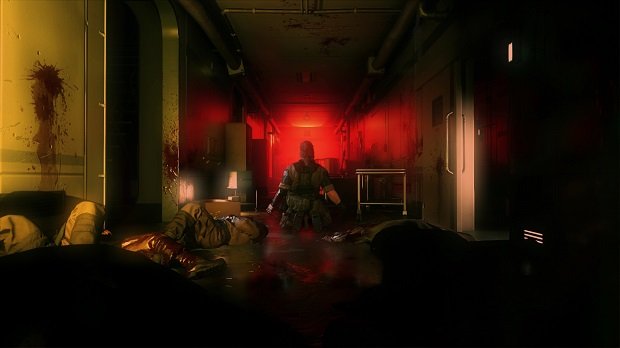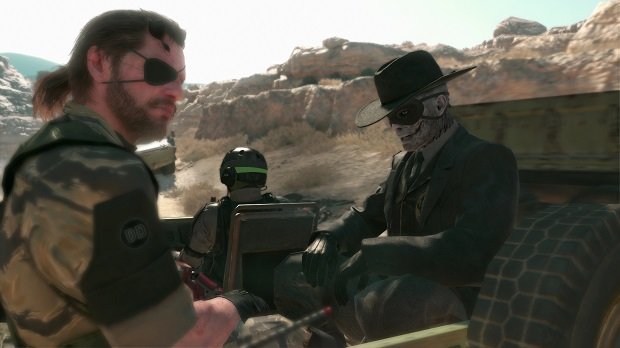Hideo Kojima, Metal Gear, and the art of the fake-out
Warning: Metal Gear series spoilers throughout
No game this generation has occupied my headspace quite like Metal Gear Solid 5: The Phantom Pain. I've spent many a late night poring over every trailer, gameplay video, and article I can find, obsessively scouring them for something - anything - that will reveal itself in some grand eureka moment. Something feels like it's missing. Like we're not getting the full picture. Like The Phantom Pain is hiding a twist the likes of which we've never seen before. And as the swansong of master prankster Hideo Kojima, I would expect nothing less.
I realize that I sound like a conspiracy theorist, like I've been staying up until the wee hours of the morning staring at a corkboard covered in grainy photographs and yards of red twine, but any Metal Gear fan will tell you that you should always expect the unexpected when it comes to whatever Kojima works on. It's not just that his games are filled with numerous winking asides to the player to remind them that they're playing a video game; his japes extend outside of the games themselves and into the real world.

Metal Gear Solid 2's bait-and-switch is practically legend at this point, but it's hardly the only time Kojima used the press cycle to pull one over on his fans. For Metal Gear Solid 4, virtually every gameplay video and demo Kojima provided focused on a war-torn Middle East, a location that actually only takes up a fraction of MGS4's total run-time. The bizarre loading screens showing a chain-smoking Snake and the random futuristic FMV sequences were the tip of the iceberg; players would soon discover that Snake's travels would take them to a European city under the grips of martial law, back to the frigid island of Shadow Moses, and face-to-face with the series' ultimate villain Big Boss in the game's final encounter (read: a 70-minute cut-scene). Once again, fans thought they had the game pegged before release, only to get blindsided by another array of twists.
Which brings us to Metal Gear Solid 5, a two-pronged assault that includes Ground Zeroes and The Phantom Pain, and is allegedly Hideo Kojima's final Metal Gear game. Ground Zeroes was introduced at PAX 2012 as a Metal Gear Solid title, but the announcement for The Phantom Pain took a vastly different approach. Revealed at the 2012 VGA's as a game from a brand new dev team known as Moby Dick Studios, The Phantom Pain was filled with clues that led Metal Gear fans to believe that this was the final entry they've been waiting for. A character who looks an awful lot like Snake awakens from a years-long coma and is led by a man whose face is covered in bandages through a hospital currently under siege. The title of the game flashed briefly on screen, along with a few random etchings above the words 'The Phantom Pain' - fans filled those etchings in later to reveal the words 'Metal Gear Solid V'. And the developer behind this mysterious title from Moby Dick Studios? Joakim Mogren - 'Joakim' of course being an anagram for 'Kojima'. An interview with Geoff Keighley shortly before GDC in 2013 showed Mogren's face covered in gauze, the result of an 'accident'. At the actual conference, a man covered in bandages stepped on stage to reveal himself as Hideo Kojima, the director behind The Phantom Pain.
These kinds of secrets, these tricks that Kojima plays leading up to each game's release - it's all part of the fun of being a Metal Gear fan. Ever since that fake out in MGS2, fans have taken it upon themselves to scrutinize every trailer or scrap of information for some hidden clue, and Hideo Kojima is more than happy to oblige. In this case, it means leaving nuggets of information about The Phantom Pain's true identity and throwing in numerous allusions to the classic Herman Melville novel, Moby Dick in order to tease the game's biggest secrets.

An entire legacy of Metal Gear games makes me question the veracity of what we've seen so far. Who the hell are we really playing as in The Phantom Pain? Are we actually Big Boss, aka Punished Snake, aka Venom Snake? Or are we this bandaged character in the hospital, who refers to himself as 'Ishmael', who also happens to be voiced by Kiefer Sutherland? The events in the hospital shown at GDC 2013 - are those events real? Or some kind of dream-like sequence meant to further mess with our perceptions of the reality dictated by the game? Why is Big Boss hanging out with Skull Face (the villain portrayed in Ground Zeroes) in the E3 2015 trailer - and why does the horn-like shrapnel embedded in his head continue to grow? Who is The Phantom Pain's 'Ahab'? There's something strange going on here, and as much as I want to figure out what it is, I can't wait for that moment where Kojima winks at me from behind the TV screen and whispers "Gotcha" when that moment finally arrives.
Weekly digests, tales from the communities you love, and more
There's value in the unknown, and Kojima knows it. We live in an age of the internet, of drip-fed PR cycles, where every gameplay feature and character detail is laid out (or leaked entirely) before a game even hits shelves. Rather than explain the plot of The Phantom Pain and who its important players are, Kojima is being deliberately coy with details, providing the barest of minimum of context to work a fanbase up into a frothing frenzy. And fans have taken the bait, coming up with some completely wild conspiracy theories that try to piece together this puzzle into some kind of cohesive whole before the game comes out. The wildest part, though? They all sound plausible, given the history Kojima has with punking his audience.
Every single trailer I watch provides me with more questions than it does with answers, and I feel like I don't have a full grasp of everything The Phantom Pain is truly about. Hell, I actually got to play the game for 16 hours a few months ago, and I feel like everything I played is some kind of ruse - nothing but smoke and mirrors to distort what the real Phantom Pain is going to be. If this happened with any other game or series I'd be frustrated and a little bit put-out by this level of obfuscation, but with Metal Gear, I welcome it. I embrace the ruse, because I want to be a willing participant in my own deception.

Kojima's approach to Metal Gear isn't just about trying to sell you a game, it's about trying to sell you a conversation. He wants you to ask questions, to dig deeper, to discuss your theories with fellow players. He wants to trick you because he wants you to go back months after the game comes out and seek out the clues that were hidden there all along. And I'm more than willing to play along, to hunt down the answers to these questions, to feel like I'm investigating a mystery years in the making. So I continue to re-watch trailers, read message boards, and head as far down the Metal Gear rabbit hole as I can before The Phantom Pain's release in September. There's value in the surprise, but there's also value in the quest for knowledge, and Kojima's approach to The Phantom Pain appeals to both of these sensibilities.
Knowing Kojima, there's still some ace in the hole for The Phantom Pain that he's held secret this whole time, and it's going to blindside all of us even more than Raiden did in Metal Gear Solid 2. Like a magician who has to get in one last mind-melting illusion before he disappears forever, I have a feeling that Hideo Kojima's final trick is going to be the most impressive one of all. I can't wait to be fooled.



